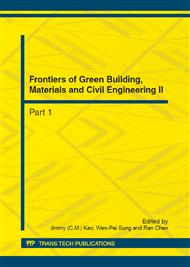[1]
Miguel A. Climent, Guillem de Vera, Jesu´s F. Lo´pez, Estanislao Viqueira, Carmen Andrade: Test Method for Measuring Chloride Diffusion Coefficients through Nonsaturated Concrete [J]. Cement and Concrete Research, 2002 (32): 1113-1123.
DOI: 10.1016/s0008-8846(02)00750-0
Google Scholar
[2]
Yang L F, Chen Z, Wang Y, Meng W, Song L F, Feng Q G: Boundary element method for analysis of two-dimensional chloride diffusion in concrete[J]. Journal of the Chinese Ceramic Society, 2009, 37(7): 1110-1117(in Chinese).
Google Scholar
[3]
Li R, Yang L F, Chen Z: Two- dimensional finite element simulation for chloride diffusion in concrete [J]. Concrete, 2008(1): 36-39(in Chinese).
Google Scholar
[4]
Chun Qing Li: Reliability Based Service Life Prediction of Corrosion Affected Concrete Structures [J]. Journal of Structural Engineering, 2004, 130 (10): 1570-1577.
DOI: 10.1061/(asce)0733-9445(2004)130:10(1570)
Google Scholar
[5]
Seung-Woo Pack, Min-Sun Jung, Ha-Won Song, Sang-Hyo Kim, Ki Yong Ann: Prediction of time dependent chloride transport in concrete structures exposed to a marine environment [J]. Cement and Concrete Research, 2010 (40): 302-312.
DOI: 10.1016/j.cemconres.2009.09.023
Google Scholar
[6]
Ha-Won Song, Hyun-Bo Shim, Aruz Petcherdchoo, Sun-Kyu Park: Service life prediction of repaired concrete structures under chloride environment using finite difference method [J]. Cement & Concrete Composites, 2009 (31): 120-127.
DOI: 10.1016/j.cemconcomp.2008.11.002
Google Scholar
[7]
Zoubir Lounis and Lamya Amleh: Reliability-based prediction of chloride ingress and reinforcement corrosion of aging concrete bridge decks – a case study investigation [C]. The Joint Commission on Structural Safety Workshop on Probabilistic Modeling of Deterioration Processes in Concrete Structures, Lausanne, Switzerland, March 24-26, 2003: 139-147.
DOI: 10.1061/40707(240)13
Google Scholar
[8]
Jafar Sobhani, Ali Akbar Ramezanianpour: Service life of the reinforced concrete bridge deck in corrosive environments: A soft computing system [J]. Applied Soft Computing, 2011 (11): 3333-3346.
DOI: 10.1016/j.asoc.2011.01.004
Google Scholar
[9]
Jung S. Kong, Ayman N. Ababneh, Dan M. Frangopol, Yunping Xi: Reliability analysis of chloride penetration in saturated concrete [J]. Probabilistic Engineering Mechanics, 2002 (17): 305-315.
DOI: 10.1016/s0266-8920(02)00014-0
Google Scholar
[10]
Collins J D, Thompson W T: The eigenvalue problem for structural systems with uncertain parameters [J]. AIAA, J., 1969, 7(4): 642-648.
Google Scholar
[11]
Shinozuka M, Astill J: Random eigenvalue problems in structural mechanics [J]. AIAA, J., 1972, 10(4): 456-462.
DOI: 10.2514/3.50119
Google Scholar
[12]
Hisada T, Nakagiri S: Role of the stochastic finite element method in structural safety and reliability [J]. Proc. 4th Int Conf. on Struct. Safety and Reliability Kobe, Japan, 1985, (5): 213-219.
Google Scholar
[13]
Marcin Kamin´ski: Generalized perturbation-based stochastic finite element method in elastostatics [J]. Computers and Structures, 2007 (85): 586–594.
DOI: 10.1016/j.compstruc.2006.08.077
Google Scholar
[14]
Knabe W, Przew ócki J and Róźy ski G. Spatial averages for linear elements for two-parameter random field [J]. Probabilistic Engineering Mechanics, 1998, 13(3): 147-167.
DOI: 10.1016/s0266-8920(97)00015-5
Google Scholar


